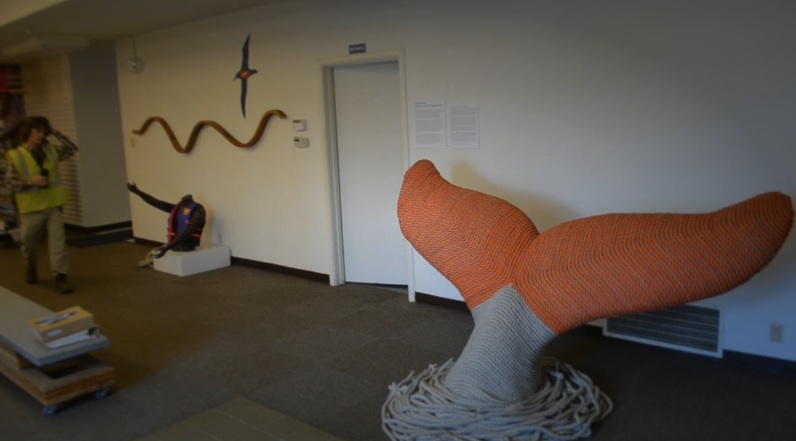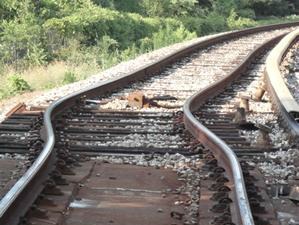
WMATALast summer, high temperatures caused a “heat kink” in the D.C. metro tracks.
Having trouble beating the heat this summer? Imagine how your infrastructure feels.
Last summer, we told you about extreme heat leading to buckling roads, melting runways, and kinky railroad tracks. Now we’re also hearing about droopy power lines and grounded airplanes.
NPR’s Science Friday hosted a discussion last week with Vicki Arroyo, executive director of the Georgetown Climate Center, about how cities can adapt to hotter temperatures and other climate impacts like floods and rising sea levels. Here’s Arroyo:
… the thing to keep in mind is that this infrastructure is built for the past conditions in our local area. So, it’s not to say that we can’t change our infrastructure with climate change in mind, whether it be climate change impacts along the coast, like storm surge or sea level rise, but it’s obviously going to take time and it’s going to take money.
Arroyo and host Ira Flatow talked about some of the solutions cities are considering or already implementing to make their systems more resilient. The simplest and most obvious one: locating backup generators above ground level so flooding won’t render them useless. (Arroyo also points out the irony that backup generators are powered by fossil fuels.) Utilities have started to build power lines with shorter, squatter telephone poles less likely to be felled in a windstorm; D.C. is even beginning a project to bury its power lines underground, although that approach doesn’t make as much sense for flood-prone areas. A caller named Jim from St. George, Utah, talks about how reflective building materials enhance the urban heat island effect. D.C. is also helping property owners install green roofs with the revenue from a plastic-bag fee.
In terms of preventing the kind of massive system failure that, after Hurricane Sandy, stranded folks in high-rise apartment buildings without heat or electricity for over a week, Arroyo points to distributed power and smart grids as a solution, and also notes that having a fleet of vehicles not powered by oil comes in handy in a disaster situation:
Smart Grid, which we often think about [as necessary] for distributed generation and renewable power to come online, can also be an important solution when it comes to some of these extreme weather events because you can actually cut off the power of the system that’s down and you can reroute power, especially to the places like hospitals and schools that you need to [restore power to] right away. And we also saw after Superstorm Sandy that some of the clean fuel vehicles — the natural-gas trucks in Long Island, for example — were able to remove debris when everybody recalls there were those long lines for weeks at a time for regular gasoline and diesel.
But as Arroyo noted above, the problem with such large-scale solutions is — you guessed it — money. Government at every level, reluctant to push for any project that would incur more debt, is holding off on crucial infrastructure upgrades. But as a New York Times guest columnist points out, the future cost of not making these improvements is far greater:
A prudent investment is one whose future returns exceed its costs — including interest cost if the money is borrowed. Opportunities meeting that standard abound in the infrastructure domain. According to the American Society of Civil Engineers, the nation has a backlog of some $3.6 trillion in overdue infrastructure maintenance. …
Austerity advocates object that more deficit spending now will burden our grandchildren with crushing debt. That might be true if the proposal were to build bigger houses and stage more lavish parties with borrowed money — as Americans, in fact, were doing in the first half of the last decade. But the objection makes no sense when applied to long-overdue infrastructure repairs. A failure to undertake that spending will gratuitously burden our grandchildren. …
Now austerity backers urge — preposterously — that infrastructure repairs be postponed until government budgets are in balance. But would they also tell an indebted family to postpone fixing a leaky roof until it paid off all its debts? Not only would the repair grow more costly with the delay, but the water damage would mount in the interim. Families should pay off debts, yes, but not in ways that actually increase their indebtedness in the longer term. The logic is the same for infrastructure.
While we’re waiting for lawmakers to figure out that infrastructure improvements — which also create jobs, by the way — are a worthy investment, here’s a sobering reminder from Arroyo of just how crucial an organized government response is in a disaster situation:
I mean, how many of us have provisions if we have an extreme storm event that puts out power for a few days to be able to, you know, have the food and the water that we need, to be able to have a backup if, you know, we’re only on cell phones and those go down. How do we communicate with people? I mean, people really do need to make plans for this at every level of government in our society.



